Messina off-ball screens
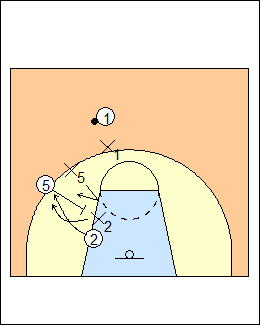 | 1 Ettore Messina EuroLeague Online Clinic The best way to break offensive timing is to take away passing lanes and preferred angles. Defending off-ball screens, the on-ball defender has to be aggressive to prevent easy reads of passing options, the defender of the screener has to let his teammate know that a screen is coming, and defenders have to help in the passing lane. See Defence - Off-ball screens. a) Ballside screen The defender guarding a player getting a screen has to know where the ball is. If the ball is on the same side of the court as the screen, X2 chases cutter 2, forcing him to curl around the screen, space is reduced with six players. When the screen is set close to the ball, X5 makes contact with 5, ready to fake a switch to force the cutter to take a longer path, and to body-check if the cutter tries to curl the screen. If X5 stays between 5 and the ball, he can more easily defend a low-post feed if the ball is passed to the wing. If X2 goes over the screen (ballside), 2 could flare to the corner for an easy pass and shot, or space to drive. (Variation) - X5 leaves a gap, X2 can chase or use the gap, see Defending - Woodley cross-down screens, Defence - Pitt off-ball screens. |
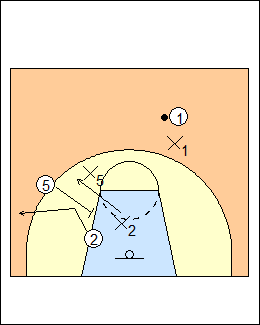 | 2 b) Weakside screen If the ball is on the opposite side of the court from the screen, X2 goes over the screen (ballside), cutting between the screen and X5 (shown), or going over both 5 and X5. The shooter will likely flare to the corner, where only a risky skip pass can be attempted. X5 needs to know whether to step back to let X2 through, or body up to the screener, which allows him to stay in contact in case the ball is passed to the wing. Chasing 2 around the screen would be a big mistake, the shooter has a lot of space after coming off the screen, forcing help from X5. |
 | 3 c) Switching Switching has become an aggressive tactic to prevent key passes in an offence or to particular players. Unlike a passive switch called by a defender being screened, the screener's defender calls the switch and jumps into the passing lane looking to intercept a pass. A switch is more likely between defenders who play a similar position or have a similar physical size, avoiding mismatches (you can set rules about who can switch, and when). Here X3 and X1 switch on a downscreen, X3 aggressively denies a pass to 1, who won't be able to cut backdoor due to lack of space, and X1 denies a high-low pass to 3 in the low post. The switch has prevented ball rotation, making the offence very static. See Defending - 4 on 4 Diamond. |
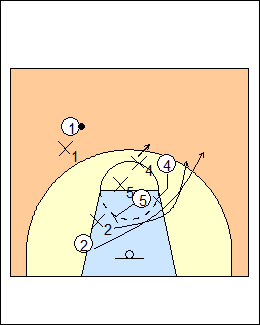 | 4 d) Staggered screen X2 chases around the first screen, then decides whether to keep chasing around the second screen, or go over. If the defender of the second screener (here X4) hedges to help X2, X5 is effectively defending 5 and 4 for a couple of seconds, but the tight space makes it very difficult to make a pass inside. Switching - if it is impossible for X2 to chase a dangerous player around a staggered screen set by two large players, the alternatives are a) X2 and X5 switch, with X5 waiting on the baseline side to get around the screen with 2 (X2 goes ballside to pick up 5), or b) consecutive ballside switches between X2 and X5 then X5 and X4, who will deny a pass with a full frontal defence, a backdoor cut by 2 is difficult due to lack of space. Herb Brown - a) have X2 trail the first screen then shortcut the second screen, or go through to deny 2 (X4 leaves a gap), if beaten, X2 can tell X4 to switch up the line; b) try to lock and trail, X5 and X4 stand up the screeners, maybe switch the second screen or shoot the gap. See Defending - Woodley single-double. |
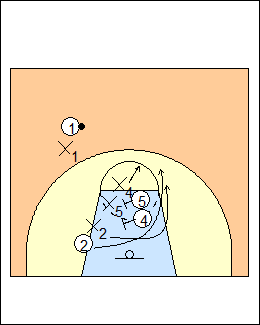 | 5 e) Double screen Always chase around a double screen, regardless of where the ball is, the defender of the screener closest to the ball hedges, helping if the cutter curls around the screens. If X2 tries to go over both screens, he can't recover if 2 flares to the corner, giving up an uncontested shot. It's possible to switch a double screen. See Defence - Pitt off-ball screens. |
 | 6 f) Little-big cross-screen Normally X5 will avoid the screen by going under, X2 then body checks 5 to slow down his cut over the screen, the advantage is that X2 is in a denial position if screener 2 is a shooter who continues out to the three-point line after screening. The disadvantage is that 5 can easily cut to the high post for an uncontested shot. See Defence - Pitt off-ball screens. |
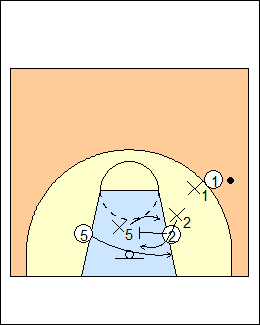 | 7 To avoid this problem, X5 goes over the screen, forcing 5 to go under, where X2 slows down his cut. It could be a tricky situation if 2 then runs out to the three-point line to catch and shoot while X2 is body-checking 5, but the defence has the advantage that 5 is very close to the baseline and 1 does not have a passing angle to get him the ball. See Attack/Defend - 3 on 3 cross-screen downscreen (X2 can gap, X5 goes over the screen and under X2), also 3 on 3 UCLA-ballscreen (gap or squeeze on a UCLA screen). (Variation) - X2 extends the screen but does not hedge low, see Defending - 4 on 4 Diamond, Woodley cross-down screens, Defence - Pack line.  |
This page was made with Basketball playbook from Jes-Soft